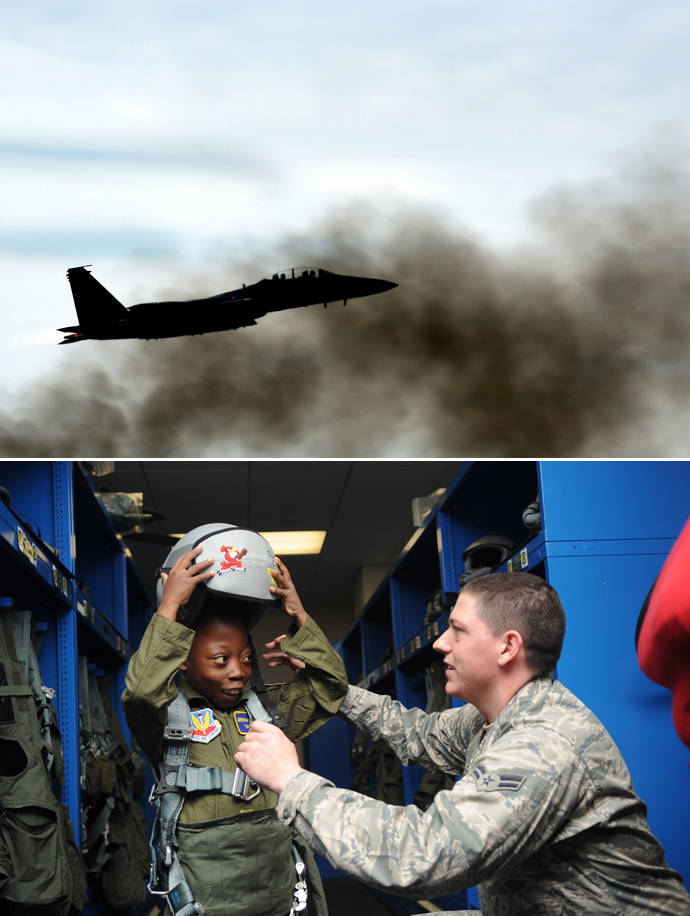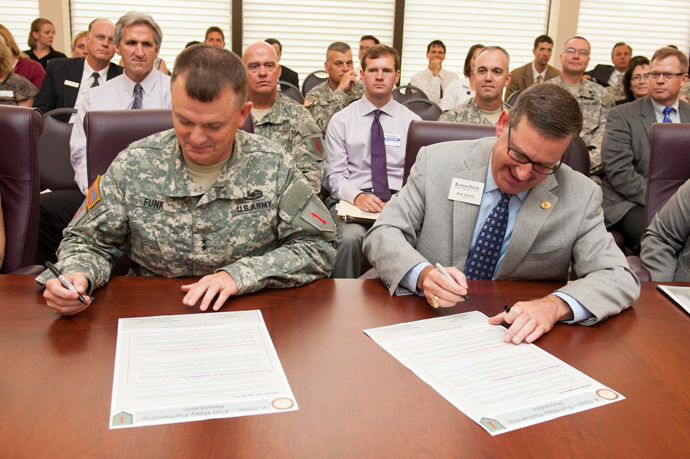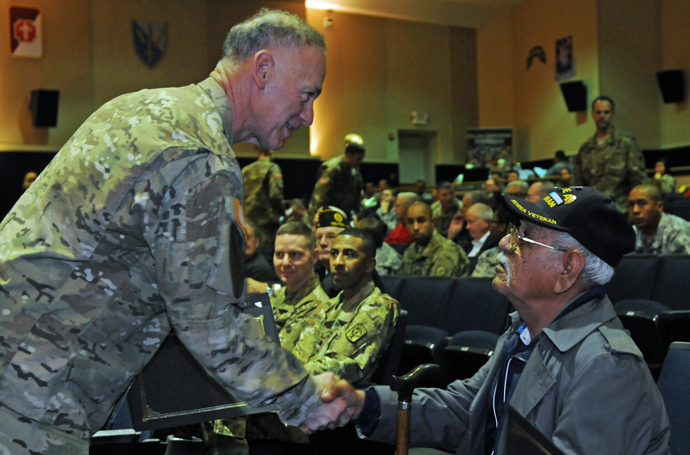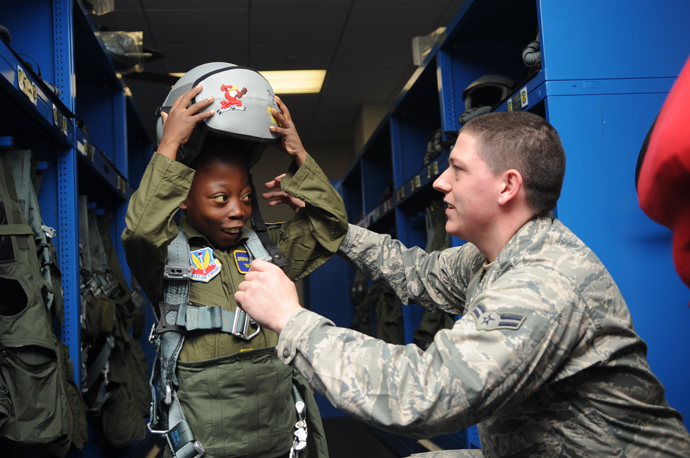The Association of Defense Communities (ADC) and the Defense Communities Caucus earlier this year designated 10 communities from across the nation as “Great American Defense Communities” for providing unwavering support to service members and military families.
The Great American Defense Communities program, with support from CBRE and Sodexo, was launched to acknowledge the unique contributions cities, counties and regions that host installations make to improve quality of life for service members, veterans and their families. This inaugural class of communities was selected by a panel of defense community advocates and experts from dozens of nominees based on the broad range of efforts they carry out on behalf of military personnel and their families, covering areas such as education, job opportunities, housing, family support during deployments and community appreciation.
“All 10 of our inaugural class of honorees truly embodied the ideals this initiative was designed to celebrate — making host communities for our nation’s military installations ‘Great Places to Call Home,’ ” said ADC CEO Tim Ford.
In collaboration with ADC, Site Selection here presents highlights from that inaugural class. For more information about these stars and others, visit defensecommunities.org.
Colorado Springs, Colorado
Because Colorado Springs is home to five military installations — Fort Carson, United States Air Force Academy, Peterson Air Force Base, Schriever Air Force Base and Cheyenne Mountain (home to NORAD/Northcom), Air Force Space Command and Fort Carson — the aerospace and defense sector is the leading economic engine in the region. The bases employ approximately 60,000 people and contribute almost $6 billion to the local economy. “Several hundred defense contractors, employing more than 10,000 highly skilled engineers and technicians, support the military missions,” says the Colorado Springs Regional Business Alliance says. Examples of those missions? Air Force Space Command, headquartered at Peterson Air Force Base, determines requirements and programs the resources for the Air Force Space budget of approximately $7.4 billion per year.

The second largest employer in the state of Colorado, Fort Carson has over 20,000 employees, is home to the 7th Infantry Division Headquarters, and features 377,000 acres of training area. Fort Carson is also the first military installation to privatize its base housing, a 50-year, $3-billion contract. The fort is used to recognition: It was recognized by the Army as a “Community of Excellence” in 1998.
The April 2015 “Report On the Comprehensive Military Value and Economic Impact of Department of Defense Activities in Colorado” from the Department of Military and Veterans Affairs found that the economic impact from DoD expenditure in Colorado is $27 billion, supporting 170,000 jobs in the state (5.2 percent of the total) and $11.6 billion in earnings (7.5 percent of the total).
It could be more soon. Colorado Governor John Hickenlooper in May 2016 signed into law the Colorado Cybersecurity Initiative, which aims to create a National Cyber Intelligence Center (NCIC) on the campus of the University of Colorado – Colorado Springs. According to one estimate, more than 100 cyber-related defense and commercial firms are located in the Springs.
Dayton Region, Ohio
“What makes the Dayton region such a powerful economic engine for defense-related business?” asks the Dayton Development Coalition. “Start with Wright-Patterson Air Force Base, one of the largest, most diverse, and organizationally complex Air Force installations in the world,” and the largest single-site employer in Ohio. “Add the Springfield Air National Guard Base, which is focused on intelligence, surveillance, and reconnaissance for the federal and state government. Amplifying both of these assets is the Air Force’s commitment to define the region as the national center of excellence in aerospace research, medicine, intelligence, education, acquisition, and tech commercialization.” Southwest Ohio’s defense installations account for more than $4.5 billion annually and employ more than 27,000 people.
The Dayton Region Military Collaborative provides a monthly forum for defense and community leaders to discuss important issues. The Wright-Patterson 2020 committee was founded to secure and fulfill the gains made through the 2005 BRAC initiative (about 1,200 relocated military and civilian positions) and to promote the assets of Wright-Patterson Air Force Base and the Springfield Air National Guard. The five key goals for Wright-Patt 2020 are to successfully implement BRAC 2005; increase the military value of regional defense installations; enable future technologies; increase commercialization opportunities and strengthen the regional contractor base; and define the Dayton region as the national center of aerospace research, development, acquisition, and commercialization.
Eglin-Hurlburt Community, Florida
The Economic Development Council of Okaloosa County, Florida’s Defense Support Initiatives (DSI) is recognized by the State of Florida as the official representative and the lead agency for the Eglin complex’s base/community initiatives. The county, along with its neighboring Santa Rosa and Walton Counties, is home to the largest Air Force Base in the world — Eglin Air Force Base. The land reservation provided by Eglin AFB encompasses three military installations; Eglin AFB, Hurlburt Field, and Duke Field, collectively known as the Eglin Test and Training Complex.

“At Hurlburt, one of our priorities is creating an environment for Airmen and families to thrive,” said Col. Sean Farrell, commander of the 1st Special Operations Wing. “The community support our Airmen and families receive here on the Emerald Coast is a tremendous part of creating that environment.” The military presence in Okaloosa County can provide more than 70 percent of the area’s overall economic activity. CareerSource Florida and Enterprise Florida released the Florida Defense Factbook in September 2015, reporting the following:
- Total statewide economic impact is $79.8 billion, providing over 774,721 jobs.
- Total defense spending accounts for nearly $34.7 billion.
- Northwest Florida regional output is driven by defense spending; $20.4 billion or 35 percent of the region’s GRP.
- Defense activities in Northwest Florida generate an estimated 192,000 jobs.
Seven of the 10 largest defense contractors in Florida have a presence in Okaloosa County, which is also home to about 300 businesses catering to the local military installations.
Due to the high density of technology-based and defense contracting firms, the EDC created the Technology Coast Manufacturing and Engineering Network, TeCMEN.
Meanwhile, there were just under 33,000 veterans living in Okaloosa County in 2015 ‐ over 15 percent of Okaloosa’s total population. The veteran population will grow by nearly 1,000 in Okaloosa County by 2022 and grow to nearly 36,000 by the 2040s. Among the target sectors with which the separating veterans’ skills match up well are general manufacturing; aerospace; maintenance, repair and overhaul (MRO); healthcare; and IT.
Ft. Leonard Wood Region, Missouri
Fort Leonard Wood (FLW) has evolved from a small basic training post more than 70 years ago to a premier Army Center of Excellence that trains more than 80,000 military and civilians each year in active component courses. The installation has received gains in prior BRACs for three U.S. Army training schools, their brigades and the Prime Power School, and also has received discretionary gains of inter-service and joint training missions for the U.S. Marine Corps, U.S. Navy, and U.S. Air Force which are integral parts of the post’s mission. All DoD training for earthmoving, truck driving, civil support, and CBRN first responders happens at Fort Leonard Wood.
About 12,000 to 13,000 people from 120 reserve and other non-tenant units train at FLW yearly. It also trains one of every five new soldiers entering Army basic combat training; and 25 to 30 percent of women in the Army start their careers at FLW, as it is one of only three gender-integrated reception sites. FLW also is a leading employer and economic engine, employing a highly professional and motivated civilian workforce of 7,500 people in a variety of fields. The post’s typical supported population includes 12,000 Service members in training; 6,600 military permanent party; 12,700 military family members; and 59,000 retirees and their families. FLW was ranked third in Forbes’ list of fastest-growing small towns in America.

The installation is Missouri’s fifth largest employer and supports 36,400 direct and indirect jobs. Even better: Over the past several years, just shy of 60 percent of military retirees chose to make the communities around Fort Leonard Wood ‐ such as Lake of the Ozarks ‐ their lifelong homes. Across the state, Fort Leonard Wood has signed 13 Army Community Covenants — more than any other Army installation.
The University of Missouri Technology Park at Fort Leonard Wood is the first technology park in the nation to be located on an active Army post. The 62-acre park was developed by the University of Missouri and the Missouri Department of Economic Development with the backing of Fort Leonard Wood.
Goldsboro, North Carolina
In a February 2016 letter, Colonel Mark Slocum, Commander, 4th Fighter Wing of Seymour Johnson Air Force Base, shared his thoughts on the community and its support: “Prior to taking command here in the summer of 2014, I heard that Seymour Johnson AFB enjoyed incredibly strong community support, but I have come to realize over my last 20 months of command that no community could be a better partner or stronger supporter of the mission, the Airmen and the Airmen’s families. In my 23 years of service, I have never witnessed such support and commitment from a community.”
What’s next? North Carolina Agriculture Commissioner Steve Troxler recently announced the federal designation of 33 counties as the North Carolina Sentinel Landscape (sentinellandscapes.org) and the development of voluntary programs of incentives for landowners and local governments that desire to participate. The designation is part of a joint federal partnership between the U.S. departments of Agriculture, Interior and Defense that aims to strengthen farms, ranches and forests while conserving habitat and natural resources and protecting vital training grounds for military installations.
“This is an exciting designation and one that should help a lot of farm families in Eastern North Carolina remain on their land and continue farming,” Troxler said. “At the same time, it will help protect the beautiful and ecologically diverse natural resources along the coast and in the Sandhills, maintain forestlands and help maintain our state’s commitment to being one of the most military-friendly states in the country.”
Grand Forks, North Dakota
The Grand Forks Air Force Base’s primary mission is the Global Hawk unmanned aircraft. It is home to the 69th Reconnaissance Group and the Block 40 RQ-4 Global Hawk, a UAS that provides worldwide intelligence, surveillance and reconnaissance capability. Grand Forks Air Force Base is the only base operating three different UAS platforms — Predator A, Predator B and Global Hawk Blocks 20 and 40. The North Dakota Air National Guard and U.S. Customs & Border Protection also operate growing unmanned aircraft operations from facilities in Grand Forks and Fargo.

Grand Forks Air Force Base had a $252 million economic impact on the region in 2014, an increase of nearly 24 percent over the previous year’s $203.7 million. As reported in Site Selection in September 2015, Grand Forks County has come to terms with the U.S. Air Force on an enhanced use lease to develop approximately 220 acres (89 hectares) of underutilized land at the Grand Forks Air Force Base.” The area will be developed into Grand Sky, the nation’s first UAS targeted business park. Developers anticipate building out as much as 1.2 million sq. ft. (111,480 sq. m.) of hangar, laboratory and office space. Northrop Grumman was Grand Sky’s first anchor tenant.
Many startups in the UAS arena are supported by the University of North Dakota’s (UND) Center for Innovation, which was the first university to offer a degree program in unmanned aviation in 2009 and has the largest university training program available for unmanned aircraft systems. Among them are firms such as SkyScopes, Smart C2 and Field of View. The state’s Research ND program offers $5 million biannually in grants for research and development to organizations and companies involved in UAS research through cooperation with UND and North Dakota State University (NDSU). North Dakota has invested more than $34 million to establish the UAS test site, establish the Grand Sky UAS Business Park and advance North Dakota’s position as a hub for the nation’s growing UAS industry.
Lawton, Oklahoma
“The Lawton community has always set the gold standard for community support,” said U.S. Sen. Jim Inhofe in congratulating the Lawton community for its Great American Defense Communities designation. Maybe that’s why Mike “Coop” Cooper, chairman of the Oklahoma Strategic Military Planning Commission, was just re-elected as president of the Association of Defense Communities — the first time an ADC sitting president has been elected to a second term. “Every time I visit Lawton and Fort Sill, I see firsthand their strong sense of community and their support for our service members, their families and our veterans,” said Inhofe. “I am proud that they are being recognized for their dedication and hard work.”
Fort Sill has an annual total economic impact of $1.9 billion and is home to a military population of about 16,500 and a civilian workforce of 7,000. It is a designated U.S. Army Fires Center of Excellence, and is home to field and air defense artillery schools, an army training center, a non-commissioned officer academy amongst other functions. Lawton and the state also benefit from defense contracts with private companies for supplies, construction and various services such as healthcare and IT. Oklahoma is home to six military installations — three Air Force bases, two Army installations and one Air National Guard base. A report prepared by the Oklahoma Department of Commerce in 2011 found that the direct, indirect and induced employment associated with the military was 133,800 jobs, with average wages 14 percent higher than the state’s average wage. Impacts on state GDP totaled more than $9.6 billion in 2010 — more than 7 percent of the state’s total economy.

In a recent letter, Major General John Rossi and Command Sergeant Major Brian Lindsey wrote, “Creating a larger sense of community outside the gates of Fort Sill and finding ways to communicate a better understanding of ‘who’ and ‘what’ your Army stands for has been a special priority of ours. We have come a long way and we are proud to say, the premier relationship enjoyed by Fort Sill and our surrounding communities serves as a model of cooperative living that cities and Army installations can benefit from nationwide.”
Flint Hills Region, Kansas
Manhattan — known as the “Little Apple” and for 25,000-student Kansas State University — and the surrounding area have a close relationship with Fort Riley. Home to the First Infantry Division, Fort Riley is located just 10 minutes west of Manhattan. The 13th-largest city in Kansas, Fort Riley serves more than 48,000 soldiers, family members, retirees and Department of the Army civilians. Over 2,500 soldiers and DOD civilians live off-post in Manhattan and Riley County.
In fiscal year 2015, Fort Riley’s total economic impact on the state was more than $1.58 billion. It also advances economic development by virtue of providing infrastructure such enhanced airport facilities and improved highways and access routes. Military families also bring a wealth of experience and knowledge to the workforce and community. But there’s also a special relationship with Kansas State, renewed last September by leaders of the two institutions.
“[The Partnership with K-State] gives me access to some of the brightest minds in the country to help us solve some of these wicked problems,” said Major General Paul Funk, Commander, 1st Infantry Division & Ft. Riley. “Last year before we deployed to Afghanistan we were able to use them to give us ideas on economic development, on agriculture — you name a subject, and they have an expert on it.”
Monterey, California
Due to its strategic location, Monterey has been a key military outpost ever since the area was “discovered” and claimed for Spain by Sebastian Vizcaino in 1602. Today, five of the country’s premier military education and research institutions are located in the Monterey Bay Region, including the Army’s Defense Language Institute at the Presidio of Monterey, which accommodates approximately 3,500 Soldiers, Marines, Sailors and Airmen, as well as select Department of Defense and State members; the Naval Postgraduate School (NPS); and the Fleet Numerical Meteorology and Oceanography Center, operated by the Navy.
The Defense Language Institute and Naval Postgraduate School contribute $1.4 billion annually to the regional economy and employ a workforce of 15,670, according to the Monterey Chamber of Commerce. Additionally, the new VA Monterey Health Care Center, set to open in fall 2016 on 14 acres of the former Fort Ord military base in Marina, will be the first clinic built from the ground up to care for active duty service members, their family and all veterans under one roof. The facility will provide care for the approximately 80,000 active duty military and retired veterans living on California’s Central Coast.

The younger set is also in focus in Monterey. Thirty-five Science and Engineering Apprentice Program (SEAP) and Hartnell College interns recently participated in a summer internship at NPS designed to immerse high-achieving high school and college students into an experience that puts their book learning into practice.
“The United States has recognized there will be an imminent decline of scientific and engineering professionals,” said NPS STEM Internship Coordinator Alison Kerr. “The Department of the Navy understands this current reality, and has put together several programs to help our current scientists and engineers pass down their knowledge to inspired young students.”
South Puget Sound, Washington
The South Sound Military & Communities Partnership leads the way in this region of Washington, where local leaders praised their community’s support for Joint Base Lewis-McChord and other installations. In the nomination submitted by SSMCP, the South Puget Sound received letters of support from numerous elected, military and business officials.
Lakewood Mayor Don Anderson highlighted how SSMCP provides a regional forum to address military civilian land-use compatibility issues that may negatively affect JBLM’s mission. “SSMCP has partnered with JBLM to conduct several needs surveys to ensure local communities and businesses understand service members concerns,” Anderson said
U.S. Reps. Denny Heck, Derek Kilmer and Adam Smith wrote in a letter, “With all the South Puget Sound offers our active duty service members and their families, it is easy to see why JBLM is the Army’s No. 1 requested duty station and is home for thousands of military retirees.”
According to a 2010 study, the economic impact of the military in Washington includes $7.9 billion in installation expenditures and $5.2 billion in contract spending. The military accounts for $12.2 billion in gross state product (4 percent of total) and supports 191,600 jobs.

